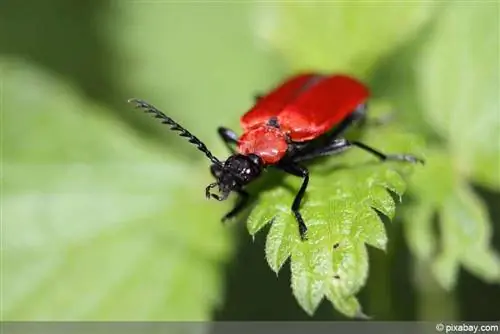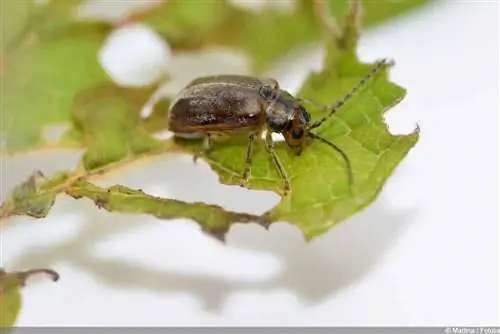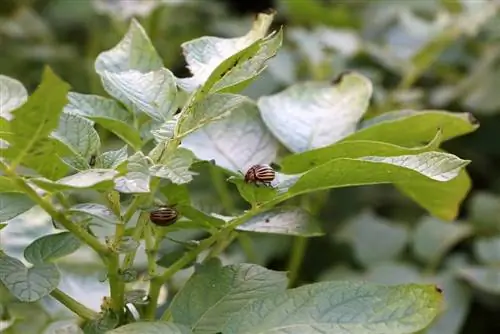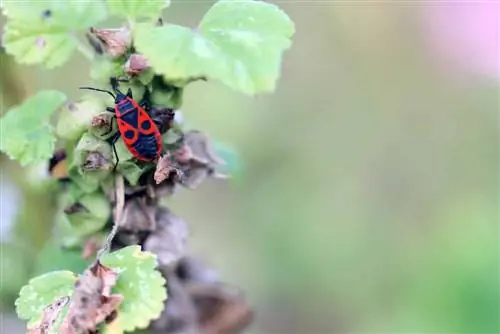- Author admin [email protected].
- Public 2023-12-17 03:39.
- Last modified 2025-06-01 06:48.
Just visually, the fire beetle looks like a fire engine, bright red. But that is not the main reason for its name. Funnily enough, he is also attracted to the smell of smoke and heat. All animals flee when there is a fire, the fire beetle comes, but not to put it out. It is quasi pyrophylous and prefers a place between tree and bark for its larvae. Especially when they are charred. What does his appearance mean for garden enthusiasts, is he a friend or foe for carefully maintained garden culture?
Appearance
Fire beetles can grow up to 2 cm long. The body of the most common scarlet fire beetle is elongated and bright red. The red cover wings are narrower at the front than at the back. It is black underneath, just like on the underside. The legs, head and antennae are also black. The antennae are body-long and toothed in the female and combed in the male. There are around 150 species worldwide, these three species are native to us:
- Scarlet Fire Beetle (Pyrochroa coccinea) - most commonly found here; as described above
- Red-headed Fire Beetle (Pyrochroa serraticornis) - is slightly smaller than the scarlet fire beetle; but also has a bright red head
- Orange Fire Beetle (Schizotus pectinicornis) - is also called the small fire beetle because it grows to a maximum length of 1 cm; the body is the same width at the back and front; the color is more brownish
All three species occur throughout southern and central Europe, but not at all in the north. The larvae of the fire beetle look similar to mealworms and are up to 3 cm long in the case of the scarlet fire beetle. The body is slightly flattened so that the larvae can move around easily under the bark. There are two thorn-shaped tail appendages (Cersus) on their abdomen and at the front they have a sharp tool so that they can drill holes through the wood if necessary.
Confusion
Very often when people talk about fire beetles, they are fire bugs. Even in the media and especially on the Internet there is often a lot of confusion about the two little animals. Pictures of fire bugs are sub titled with fire beetle, it is written about the fire bug, but what is actually meant is the beetle and vice versa. When viewed in direct comparison, both species can be easily distinguished from each other. The common fire bug is about one centimeter long and has a flat, even back. This is quite strikingly marked, with symmetrical black spots on an orange-red background. Head, antennae and legs are black. Fire bugs tend to appear in large numbers. Preferably in the sun and near mallow and linden trees. Here they do no harm, sucking on dead plant parts and insects. Because they sometimes appear en masse, some people become uncomfortable and so they are often referred to as nuisances.
Lifestyle
Fire beetles live primarily in deciduous forests. The preferred places to stay there are dead wood and low bushes with flowers. They feed primarily on sweet nectar and honeydew from aphids. The larvae develop within one to two years and spend their entire life somewhere between tree and bark in the dead wood. There they don't have to worry about competitors and they won't be crushed by the tree. A dead tree also does not secrete resin to protect itself from enemies.
Nutrition
While the beetles eat a purely vegetarian diet, the larvae are predatory. They feed on falling seeds, plant parts, insect eggs and dead insects. The larvae of other beetles and especially those of the dreaded bark beetles are also on their menu.
Reproduction
As mentioned at the beginning, the fire beetle has a special instinct for sources of fire, especially forest fires of course. Here, in the burnt dead wood, it finds a perfect habitat for the development of its larvae. The fire beetles have an infrared organ with heat-sensitive sensors. This means they can detect the sharp increases in temperature during fires over 50 kilometers away. The male fire beetle has come up with something special to court a suitable female. He offers her a cocktail of cantharidin on a furrow on her head. The male gets this defensive substance for predators from the oil beetles. These secrete cantharidin on their legs. It primarily serves as protection against ants.
There are some species of beetles that are attracted by this poison and suck it up to protect themselves or to impress the female. If the female fire beetle is satisfied with the drink, mating can occur. The sperm also contain a large amount of cantharidin, which later serves to protect the eggs from predators. So in May and June the fire beetles fly around looking for their mates. After successful mating, eggs are laid quickly. The eggs are laid in rotten or charred dead wood. The larvae do not leave this place during their entire development period. Pupation takes place in the following spring, and two months later, in May, the finished beetles hatch for their short life. The development stage from egg to beetle takes up to three years.
Usefulness
The larvae of the fire beetle eat their way beneath the bark of dead trees. They also like to use existing tunnels that other beetle larvae have left there. They often encounter the larvae of the harmful bark beetles, a treat for the fire beetle larvae. It is therefore clear that the fire beetle, including its larva, must be viewed as a beneficial insect rather than a pest. Attracted by the light, fire beetles sometimes fly into the house. But here too they are not to be feared and should be carefully led back out into the open. The fire beetle is not an endangered and therefore protected species. As long as dead wood is left in the forest, there will be a he althy population. Due to the voracity of its larvae, especially with regard to bark beetle larvae, the fire beetle is very welcome in forestry.
Conclusion
The fire beetle is fascinating in every way. Bright red and equipped with a feeling for sources of fire, he flies through his short life. Actually just to reproduce successfully. He also has a lot of fascinating tricks up his sleeve that will help you find a partner and the right place to lay your eggs. The fire beetle larvae eat other beetle larvae, including the harmful bark beetle larvae. They leave plants and what they have planted untouched. The conclusion is logical: The fire beetle is quite pretty to look at and is also a beneficial insect in forests and gardens. Attention filler text: Conclusion The fire beetle is fascinating in every respect. Bright red and equipped with a feeling for sources of fire, he flies through his short life. Actually just to reproduce successfully. He also has a lot of fascinating tricks up his sleeve that will help you find a partner and the right place to lay your eggs. The fire beetle larvae eat other beetle larvae, including the harmful bark beetle larvae. They leave plants and what they have planted untouched. The conclusion is logical: the fire beetle is quite pretty.






